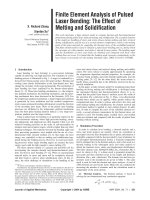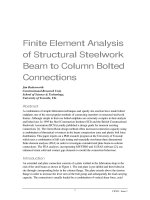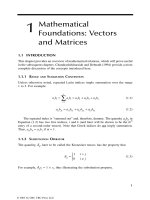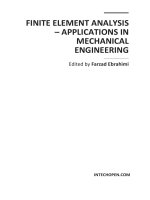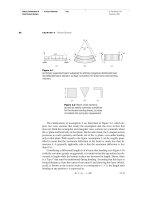Finite element analysis of piston in ansys
Bạn đang xem bản rút gọn của tài liệu. Xem và tải ngay bản đầy đủ của tài liệu tại đây (884.13 KB, 9 trang )
<span class="text_page_counter">Trang 1</span><div class="page_container" data-page="1">
Lokesh Singh<sup>1</sup>, Suneer Singh Rawat<sup>2</sup>, Taufeeque Hasan<sup>3</sup>, Upendra Kumar<sup>4 </sup>
<i><small>Department of Electronics and Communication Engineering, Amity University </small></i>
<b>Abstract-A piston is a component of reciprocating engines. Its purpose is to transfer force form expanding </b>
gas in the cylinder to the crank shaft via piston rod and a connecting rod. It is one of the most complex components of an automobile. In some engines the piston also acts as a valve by covering and uncovering ports in the cylinder wall. In present, work a three dimensional solid model of piston including piston pin is designed with the help of CATIA and SOLIDWORKS software. The thermal stresses, mechanical stresses and couples thermo-mechanical stresses distribution and deformations are calculated. After that fatigue analysis was performed to investigate factor of safety and life of the piston assembly using ANSYS workbench software. Aluminium-silicon composite is used as piston material. The stress analysis results also help to improve component design at the early stage and also help in reducing time required to manufacture the piston component and its cost.
<b>Keywords:</b>Piston, Fatigue, coupled thermo mechanical stresses, Structural Stress, Ansys<i><small>.</small></i>
In an automobile Industry piston is found to be most important part of the engine which is subjected to high mechanical and thermal stresses. Due to very large temperature difference between the piston crown and cooling galleries induces much thermal stresses in the piston. Besides the gas pressure, piston acceleration and piston skirt side force can develop cycle of mechanical stresses which are superimposed on the thermal stresses. Due to this reason thermo-mechanical stresses are one of the main causes of the failure of the piston.
</div><span class="text_page_counter">Trang 2</span><div class="page_container" data-page="2"><i><b><small>Fig 1: Some designs of pistons </small></b></i>
Thus it has become very important to discuss the thermal and mechanical stresses to improve the quality and performance of the piston. In spite of all the improvements and advancements in the technologies there exists large number of defective or damaged pistons. Thermal and mechanical fatigue plays a prominent role in the designing of pistons. Large numbers of complex fatigue tests are carried out by piston manufacturers but this involves very high cost and time .Thus finite element analysis is carried out for stresses, temperature gradient, and deformation and fatigue characteristics. In this paper, a detailed stress analysis of piston is done under various thermal and structural boundary conditions which are applied to the finite element model of the piston. Structural, thermal and coupled thermo-mechanical stresses and temperature gradient are obtained from the analysis. Life and Factor of safety for the piston are obtained from fatigue analysis. Based on the results from the analysis practical guidelines can be provided for engine design in order to improve performance and efficiency.
The material chosen for the analysis is AMC225XE.It is a high quality aluminium composite reinforced with 25% by volume of ultrafine particles of silicon carbide .It is manufactured by special powder metallurgy route using a proprietary high energy mixing process which ensures excellent particle distribution and enhances mechanical properties .The various properties of the material are shown in table 1.
<i><b><small>Table 1: Properties of material </small></b></i>
<b> </b>
Young’s Modulus,(E) 115 GPa
Tensile Ultimate strength 650 MPa Tensile Yield strength 480 MPa Compressive yield strength 480 MPa
</div><span class="text_page_counter">Trang 3</span><div class="page_container" data-page="3"><b>FINITE ELEMENT THERMO- MECHANICAL COUPLING ANALYSISIII Model of piston </b>
In this study, a full three dimensional solid model including piston and pin is introduced to the ANSYS software. Some unimportant factors, such as spot fillet, bevel edge, oil hole are neglected in the model to simplify the analysis. The three kinds of the stress fields, named as thermal stress field, mechanical stress field, thermal and mechanical coupling stress field, can be obtained by the imposition of the boundary conditions and loads on the FEA model. Model of the piston is shown in figure 2.
<b> </b>
<b><small>IV</small>Mesh generation</b>
Finite element mesh is generated using parabolic tetrahedral elements (7146 elements). The mises stress is checked for convergence. An automatic method is used to generate the mesh in the present work. The meshing of piston is shown in figure 3.
<b> </b>
<b>V Boundary condition Thermal boundary condition </b>
In the thermal analysis for model in ANSYS, the convection boundary condition, as the surface load is inflicted on the outside surface. The upper part of the piston is having very high temperature because of direct contact with the gas. So a temperature of 360 degrees is provided to the upper surface of the piston. The thermal boundary conditions of the piston are shown in figure 4<small>. </small>
</div><span class="text_page_counter">Trang 4</span><div class="page_container" data-page="4"><b>Mechanical boundary condition: </b>
freedom degrees of the piston pin are restrained to let the piston in a static condition. Coupling restraints are imposed on two points on the bottom of piston in order to eliminate the revolving of the piston around the piston pin. The surface-surface contact unit between the piston pin hole and the piston pin is set from default as ‘bonded’ to ‘no separation’ to let some displacement between piston and piston pin during the movement of the piston. The above two boundary conditions are referred as displacement restraints. The boundary conditions are as shown in figure 5.
<b><small> </small></b>
<b>VI RESULT OF THE THERMO MECHANICAL ANALYSIS </b>
The various boundary conditions and load is imposed on the FEA model and three different kinds of kinds of the stress field, named as thermal stress field, mechanical stress field, and thermo-mechanical coupling stress field can be obtained. Fig.6 shows the total von-mises stresses distribution on the whole surface of piston. Figures 7, 8, 9 shows the stresses distribution due to mechanical load, thermal load and coupled thermo-mechanical load respectively. From Fig.7, we can see that the maximum stress is 207.4 MPa, which does not exceed the material yield strength (480 MPa) and it occurs at the upper end of piston pin boss inner hole and inside the piston pin. The calculated results also indicate that the maximum thermal load is 96.014 MPa and the maximum stress of the fuel gas explosive pressure is 210.75 MPa. This fact makes clear that the explosive pressure of fuel gas is the main factor to cause the stress concentration. As shown in Fig. 10, the maximum deformation is 0.0606 mm and it occurs at the piston head. The minimum displacement is 0.00202 mm.
</div><span class="text_page_counter">Trang 6</span><div class="page_container" data-page="6">
Fig 9: Structural stress distribution <small> </small> <i><b><small> Fig 10: Total deformation </small></b></i>
<small>Table 2: Comparison between results </small>
The boundary conditions of the thermo-mechanical analysis are imported to the fatigue analysis and results are obtained. when the load imposed on the piston as gas pressure is 6.04 MPa, the life of the piston obtained as 10<sup>6</sup> cycles as shown in fig.11. Minimum factor of safety is obtained as 1.379 as shown in fig.12 and biaxiality indication is obtained as .99787 as shown in fig.13. When the gas pressure is increased to 9MPa, the minimum life obtained is 6.2 X 10<sup>5</sup> cycles as shown in fig.14, factor of safety obtained as .92 as shown in fig.15 and biaxiality indication obtained as .99109 as shown in fig. 16.
<b>Results (Ref.- 1) </b>
<b>Variation 1. </b> Equivalent von-
Misses stress
244 MPa 207 MPa 15%
</div><span class="text_page_counter">Trang 7</span><div class="page_container" data-page="7"><small> </small>
<i><b><small> Fig 11: Life of piston for 6.04 MPa Fig 12: Factor of safety for 6.04 MPa </small></b></i>
<small> </small>
<small> </small>
<i><b><small> Fig 13: Biaxiality indication for 6.04 MPa </small></b></i> <small> </small> <i><b><small> Fig 14: Life for 9MPa </small></b></i>
<i><b><small>TABLE 3: Fatigue analysis results </small></b></i>
3 Biaxiality indication .99787 -.99988
</div><span class="text_page_counter">Trang 8</span><div class="page_container" data-page="8"><b><small> </small></b>
<b>VIII CONCLUSION </b>
The following conclusion can be drawn from analysis conducted in this study:
It was found that the design parameter of the piston with modification gives the sufficient improvement in the existing results.
It was found that the maximum stress is 207 MPa which is less than the maximum tensile stress (650 MPa) and yield strength (480 MPa) of the material.
The maximum thermal stress is found to be 96.014 MPa at a maximum temperature of 360 <small>0</small>C. The minimum factor of safety is 1.379 which is greater than unity so our design of piston is safe
under the applied loading conditions.
<b>REFERENCES </b>
<small>[1] Gudimetal P., Gopinath C.V. “Finite Element Analysis of Reverse Engineered Internal Combustion Engine Piston”, Asian International Journal of Science and Technology in Production and Manufacturing Engineering (AIJSTPME), (2009) 2(4), p.85-92. </small>
<small>[2] Yanxia Wang, Yongqi Liu, Haiyan Shi “The Reliability Analysis for Pistons on Fracture Mechanics”, IEEE 2010, Vol. 4,p.173-177. </small>
<small>[3] Jadhav Rajendra B, G. J. Vikhe Patil “Computer Aided Design and Analysis of Piston Mechanism of Four Stroke S.I. Engine” IEEE 2010,Frontiers in automobile and mechanical engineering conference, p.97-103. </small>
<small>the Design Decision on Optimum Piston Configuration of Production Engine” ,Society of Autonative Engineers (SAE)paper,(1992),p. 1-5. </small>
<small>[5] F.S. Silva “Fatigue on engine pistons – A compendium of casestudies”,Elesavier, (2006),Vol. 13, p. 480-492. </small>
<small>[6] Yanxia Wang, Yongqi Liu, Haiyan Shi “Simulation and Analysis of Thermo-Mechanical Coupling Load and Mechanical Dynamic Load for a Piston”, published by IEEE,(2010),Vol.4, p. 106-110. </small>
<small>[7] Eric Chowanietz and Matthew Fonnan “A mixed-signal asic for piston temperature measurement in internal combustion engines”, published by IEEE,(1994),ASIC conference, p. 18-20. </small>
<small>[8] Yongjun Nie “Finite Element Modeling and Analysis for Key Parts of a New type Internal Combustion Engine”, International Conferences on </small>
</div>
